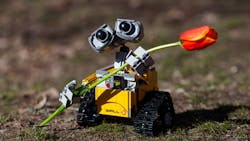Disney’s Wall-E-inspired robot is autonomous, emotional, and adorable
Key takeaways
- Robots can now autonomously interpret human body language and respond with emotional behaviors.
- Mimicking skilled operators improves robotic interaction without retraining low-level control systems.
- Combining diffusion models with transformers enables flexible, mood-driven robot responses.
- Emotionally expressive robots may enhance safety, efficiency, and engagement in human-robot workflows.
It’s official. Robotics has entered its nostalgia era, and Pixar-inspired bots are leading the way. A few weeks ago, I highlighted a robotic lamp modeled after Luxo Jr. Now, Disney Research, a network of laboratories working to pursue scientific and technological innovations, has introduced a Wall-E-esque robot that can autonomously interact with humans. With an array of moods and movements, only one question remains: where can I buy one?
A key component of any robot, whether it’s a quadruped, humanoid, or non-anthropomorphic variety, is how it interacts with humans. To date, the most successful human-robot interactions (HRI) have involved skilled operators who assess the environment and the situation before determining how the robot will interact with nearby humans. Disney Research, however, set out to achieve autonomous HRI, a bold step in the field of robotics.
From operator control to emotional autonomy: How Disney’s robot learned to interact
According to the researchers, to achieve full autonomy in HRI, you must combine decision-making, motion control, and social interactions, as well as incorporating aspects of the theory of mind. To accomplish this, the team began designing a framework that would allow a robot to pick up on human body language, react without contact, and even show different moods like a real person.
The first step in this process was to collect a human-robot interaction dataset using a human, a robot, and an external operator. To capture the data, the external operator remotely controlled the robot to interact with the human and express different moods. The team then captured the poses of both the robot and the human, along with the operator’s teleoperation commands. According to the researchers, their focus was on imitating the operator’s intent rather than the robot’s specific actions. This approach offered several benefits, including avoiding the need to relearn complex, low-level robot control.
Additionally, the team used diffusion models to mimic operator behavior and generate a range of human-robot interactions. Unlike previous motion diffusion methods that mostly focused on predicting continuous movements, this new model was able to handle both continuous commands and discrete actions. The researchers explained that the core of this method is a unified transformer backbone that includes a diffusion module for continuous signals and a classifier for discrete events.
Testing the feels: How users responded to the robot’s moods
As part of the study, the team let 20 participants interact with the robot and asked them to determine which mood the robot was in. The robot had several unique movements to indicate its mood. In the angry mood, the robot refused to interact with the human and would shake its head. In the sad mood, the robot would look at the ground, shake its head, and walk away from the human. In the happy mood, the robot would perform different dances and run towards the human. In the shy mood, the robot would follow the human around while trying to avoid eye contact.
In the second part of this study, the researchers asked the humans if they thought the robot was operating autonomously or being remotely controlled. While participants had a hard time determining if the robot was being controlled by the operator, they were able to successfully identify the mood of the robot.
The team recently published their findings on arXiv, which is owned by Cornell University. In an excerpt from the paper, titled "Autonomous Human-Robot Interaction via Operator Imitation,” the researchers wrote: “Teleoperated robotic characters can perform expressive interactions with humans, relying on the operators' experience and social intuition. In this work, we propose to create autonomous interactive robots, by training a model to imitate operator data. Our model is trained on a dataset of human-robot interactions, where an expert operator is asked to vary the interactions and mood of the robot, while the operator commands as well as the pose of the human and robot are recorded. Our approach learns to predict continuous operator commands through a diffusion process and discrete commands through a classifier, all unified within a single transformer architecture. We evaluate the resulting model in simulation and with a user study on the real system. We show that our method enables simple autonomous human-robot interactions that are comparable to the expert-operator baseline, and that users can recognize the different robot moods as generated by our model. Finally, we demonstrate a zero-shot transfer of our model onto a different robotic platform with the same operator interface.”
About the Author
Alexis Gajewski
Senior Content Strategist
Alexis Gajewski has over 15 years of experience in the maintenance, reliability, operations, and manufacturing space. She joined Plant Services in 2008 and works to bring readers the news, insight, and information they need to make the right decisions for their plants. Alexis also authors “The Lighter Side of Manufacturing,” a blog that highlights the fun and innovative advances in the industrial sector.
